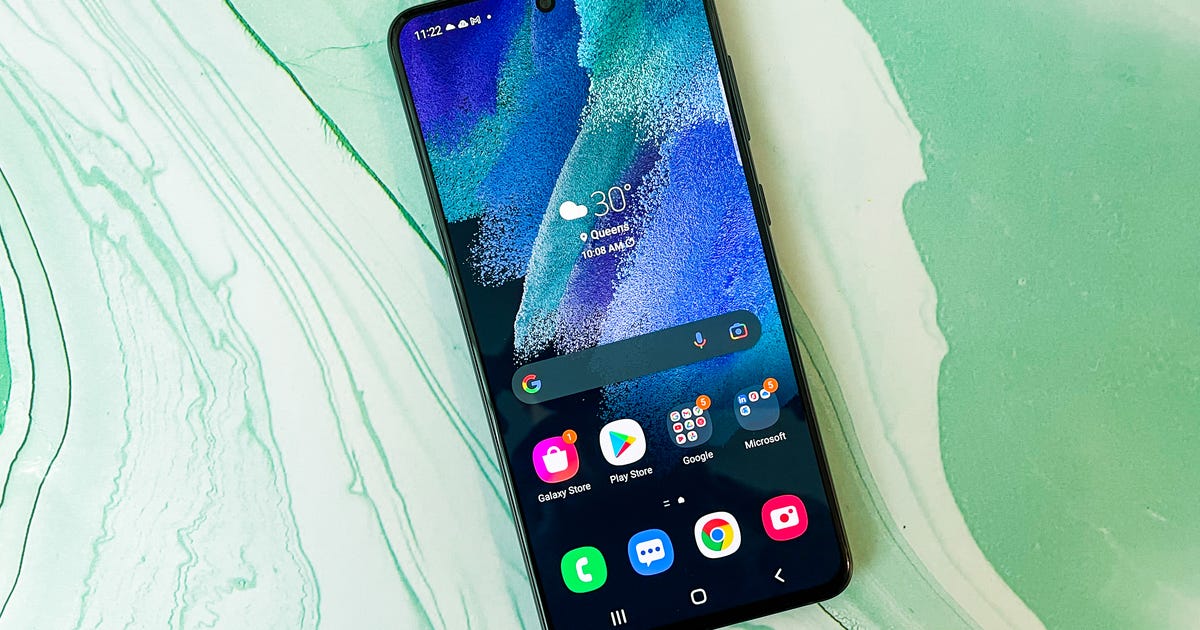
Samsung's eco-friendly CES 2022 pledge: TVs, appliances will pack recycled materials by 2025
This story is part of CES, where CNET covers the latest news on the most astonishing tech coming soon.
During CES 2022, Samsung is extending sustainability measures pioneered in its mobile and audio divisions to its appliances and TVs to make its products even more eco-friendly.
This includes expanding recycled plastics in products and packaging as well as teaming up with companies like Patagonia to chop the impact of microplastics in the oceans and environment. It continues Samsung's broader efforts to make its devices and appliances more sustainable throughout conventional and sometimes experimental endeavors, from solar-powered TV remotes to a blockchain reforestation project also announced during CES 2022.
"Every year, Samsung sells half a billion devices," said JH Han, head of Samsung Electronics. He added that that size carries department that any changes his company makes can cause ripples across the manufacturing. "Millions of everyday changes can make a meaningful impacts for our planet."
Samsung's sustainability pledges come at a time when weather change has become a key issue across many Services including politics, business and finance. Car companies have quick pledged moves to electric vehicles. Meanwhile, the tech manufacturing has begun taking on e-waste, which is exacerbated by the even upgrades of features and capabilities in its products.
Read more: Samsung's $899 travel projector turns any surface into a smart TV at CES 2022
To offset those influences, companies like Microsoft, Google and Meta (née Facebook) have pledged to reduce, offset or even reverse carbon usage in their worldwide offices and data centers. Apple additionally has built recycling robots, designed to rescue and reuse parts from unfixable devices, rather than sending them to the landfill. It's also touted features like recycled materials for its MacBooks, iMacs and iPhones, while pushing its suppliers to adopt green technology as well.
For Samsung, these efforts are showing up in the products you buy as it increases the amount of recycled plastic in home appliances, as well as developing new product parts, like components for washing machine tubs recycled from lunchboxes and face mask straps. Additionally, Samsung said it plans for TVs and visual displays to hold 30 times more recycled plastics than those produced last year.
Read more: CES 2022: Samsung's Odyssey Ark looks too lovely for gaming
Samsung vacuums and air purifiers will soon Come tucked in eco-packaging, or materials that had been previously used, which the business started doing with its phones and audio products. Samsung's even exploring ways to turn that packaging into tables or cat houses. Samsung also said at CES that it wants to push its TVs and called chargers to operate at near zero power draw when on standby, so that they consume "almost no energy" when not people used.
To help guide the company on its eco-friendly path, Samsung is teaming up with outdoor outfitter Patagonia to refine publishes and reduce the impact of microplastics on the environment. Other partnerships will expand Samsung's SmartThings Energy to help consumers boss the energy use of their networked devices, and even switch to more cost-efficient energy providers. Ultimately, Samsung said it hopes to eliminate single-use plastic from its smartphone packaging by 2025. It also hopes by that time to get reused materials in all home appliances and mobile products as well.
"We must acquire together for tomorrow," Samsung's Han said. "This is a future we must acquire together."
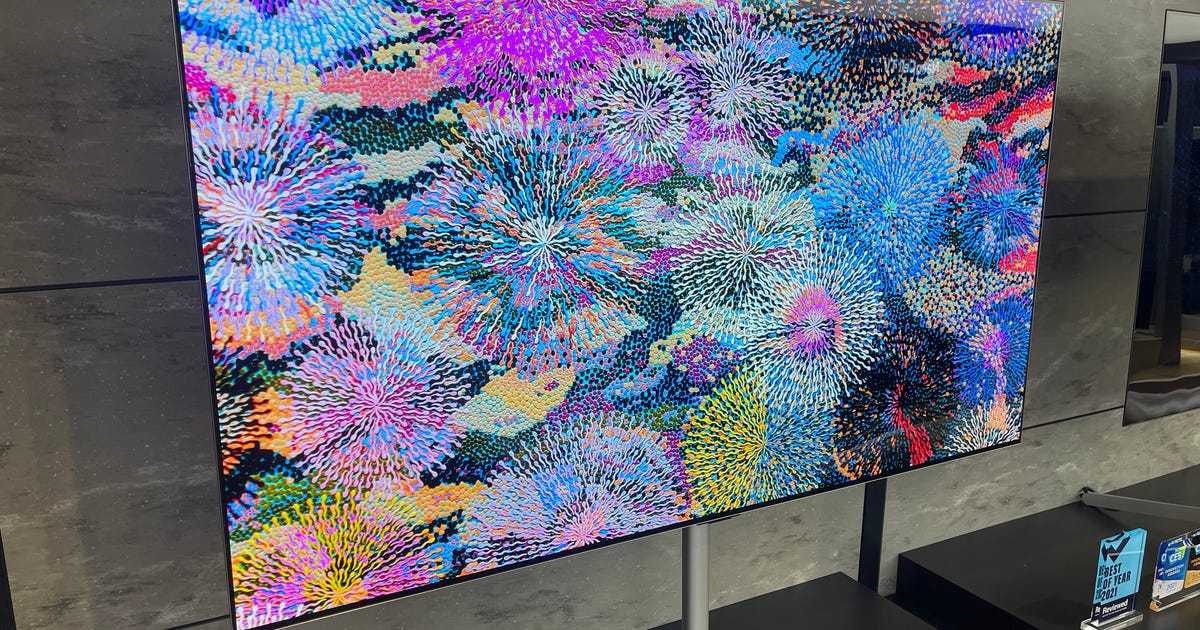
LG's 2022 OLED TVs Now Available, Starting at $1,400 for 42-inch Size
For the last few years my favorite high-end TV has been an LG OLED model, but for 2022 there's more competition than ever. LG's archrival Samsung has an OLED TV too, promising better color thanks to QD-OLED technology. Sony accounts two different kinds of OLED, including a QD-OLED of its own that looks exquisite sweet in person. And more and more TV makers are offering mini-LED models, which promise excellent image quality for much less wealth than OLED.
Meanwhile LG has started rolling out the widest array of OLED TVs yet, with five series offering sizes from 42 to 97 inches and prices from $1,400 to $25,000. First announced at CES 2022 in January, these TVs are hitting stores and online now. I haven't had the chance to study any of them yet, but based on my past distinguished and what I've seen so far, I expect LG's 2022 OLED TVs to pause to be among the best TVs on the market.
The improvement I'm most intrigued to test is improved brightness on the "Evo" models in the C2 and G2 series -- LG is claiming peak brightness of 20 percent and 30 percent higher than its non-Evo TVs. That punchier narrate is due to new "brightness boost" (on the C2) and "brightness boost max" (on the G2) processing as well as a new heat dissipation technology, which is only available on the G2.
Here's a look at prices in the C2 and G2 series, along with a reminder that they will undoubtedly fall quite a bit as the year progresses.
LG G2 and C2 2022 OLED TV pricing
Series | Model | Size | Price | Availability | Gallery Design | Evo Brightness Booster |
|---|---|---|---|---|---|---|
G2 | OLED97G2PUA | 97 | TBD | TBD | Yes | Yes (Max) |
G2 | OLED83G2PUA | 83 | $6,500 | April | Yes | Yes (Max) |
G2 | OLED77G2PUA | 77 | $4,000 | March | Yes | Yes (Max) |
G2 | OLED65G2PUA | 65 | $3,000 | March | Yes | Yes (Max) |
G2 | OLED55G2PUA | 55 | $2,200 | April | Yes | Yes (Max) |
C2 | OLED83C2PUA | 83 | $5,500 | March | No | Yes |
C2 | OLED77C2PUA | 77 | $3,500 | March | No | Yes |
C2 | OLED65C2PUA | 65 | $2,500 | March | No | Yes |
C2 | OLED55C2PUA | 55 | $1,800 | March | No | Yes |
C2 | OLED48C2PUA | 48 | $1,500 | March | No | No |
C2 | OLED42C2PUA | 42 | $1,400 | May | No | No |
How they compare to QD-OLED models, and other high-end TVs, remains to be seen, but it's unimaginative to me that Samsung's QD-OLED costs the same as the best (on paper) LG, the G2 series: $3,000 at 65 inches and $2,200 at 55 inches. Sony has yet to announce pricing on its QD-OLED TVs, but I put a question to it to be a couple hundred dollars higher.
Meanwhile the LG C2 compensations significantly less -- $2,500 at 65 and $1,800 at 55 inches -- and on paper the only narrate quality difference between it and the G2 is 10% less brightness, something I doubt most viewers will be able to indulge in. It's worth noting that the smaller 42- and 48-inch members of the C2 series lack the higher brightness.

The C2 will get an Evo panel in 2022, but LG says it won't be quite as challenging as the G2.
Richard Peterson
In the meantime, here are the other changes to LG's 2022 lineup.
Gen 5 Alpha 9 processor: LG says upscaling has been improved to remove extra steps between less-than-4K and 4K resolution, and that dynamic tone mapping had 10 times the number of sampling blocks. I expect improvements to be minor, at best, but we'll see.
42-inch and 97-inch sizes: OLED TVs are level-headed available in fewer screen size options than LCD/QLED models, but that gap will narrow further in 2022. The C2 series will get a smaller 42-inch size (shipping in May), after the G2 will add a positively enormous 97-inch version, the price and availability of which have yet to be announced.

The 97-inch G2 is the largest OLED TV yet.
Richard Peterson
8K Z2 and entry-level B2, A2 models: We query to concentrate our reviews on the C2 and G2 in 2022, but LG has three anunexperienced new series on offer as well. The Z2 is the 8K resolution series, with the 88-inch size now wall-mountable and the 77-inch size attracting a "gallery" design similar to the G2. The more-affordable B2 and A2 get lesser processors (Gen 5 Alpha 7) -- the B2 has a 120Hz refresh rate after the A2 is LG's sole 60Hz OLED for 2022. The A2 also lacks the HDMI 2.1 features, including 4K/120Hz input capability, found on the other 2022 LG OLEDs.
LG Z2, B2 and A2 2022 OLED TVs compared
Series | Model | Size | Price | Availability | Resolution | Processor | Refresh rate | HDMI version |
|---|---|---|---|---|---|---|---|---|
Z2 | OLED88Z2PUA | 88 | $25,000 | April | 8K | A9 Gen 5 | 120Hz | 2.1 |
Z2 | OLED77Z2PUA | 77 | $13,000 | April | 8K | A9 Gen 5 | 120Hz | 2.1 |
B2 | OLED77B2PUA | 77 | $3,300 | March | 4K | A7 Gen 5 | 120Hz | 2.1 |
B2 | OLED65B2PUA | 65 | $2,000 | March | 4K | A7 Gen 5 | 120Hz | 2.1 |
B2 | OLED55B2PUA | 55 | $1,500 | March | 4K | A7 Gen 5 | 120Hz | 2.1 |
A2 | OLED65A2PUA | 65 | TBD | TBD | 4K | A7 Gen 5 | 60Hz | 2.0 |
A2 | OLED55A2PUA | 55 | TBD | TBD | 4K | A7 Gen 5 | 60Hz | 2.0 |
Design changes: The G2 retains the ultrathin "gallery" perform from last year, allowing it to hug the wall more closely than the C2. Bezel size about the picture for both series has been narrowed, to 10.2mm on the G and 6mm on the C, for an even more dramatic "all-picture" look. There's also a new carbon-fiber material that contributes to significantly less weight: the G is 20% lighter and the C up to 47% lighter.
Gaming extras: The C1 was my Popular TV for gaming thanks to its best-in-class input features, including VRR and 4K/120Hz capability on every input on the C and G models, and improvements in 2022 are minor. The excellent Game Optimizer mode against a new "sports" preset to join RPG, FPS and the rest, there's a new dark room mode that reduces brightness and adds blue Delicious reduction to combat eye fatigue and the dashboard shows more question on the pop-up.
LG says that premium 2022 OLEDs will also get up to 48Gbps bandwidth on their HDMI inputs, up from 40Gbps in 2021 and 2020 models. Since bandwidth is a poor indicator of real-world video quality I don't Great the improvement a big deal. (Here's a good explanation of why.)
User profiles on WebOS shining TV: All 2022 LG TVs with its WebOS shining TV system will allow you to set up user profiles for different family members or others. These include a Kids profile that surfaces kids-friendly pleased. Google TV and Amazon Fire TV also funds profiles, but this would be a first in a proprietary shining TV system.

New for 2022, LG's WebOS shining TV system lets you set up profiles for different users.
David Katzmaier
Far-field mic for recount commands: Previously available on the G and up models, for 2022 LG is migrating its far-field mic -- which grants you to issue voice commands by saying a wake word like "Alexa" or "Hey, Google," pretty than having to use the remote -- down to the C2 series and the G2. Like Samsung TVs, LG lets you use Alexa, Google Assistant and its proprietary voice system.
Room to room sharing: This new feature, coming later this year, lets a compatible 2022 LG TV Part its screen, including inputs such as a cable box, wirelessly to new compatible 2022 LG TV. LG says it's designed to grant you to take the second TV elsewhere in the home (or outside) where a corrupt or other wired connection might not be available. The downside is that it means two 2022 LG TVs because it won't work on back models.
"Always ready" screensaver: LG is taking a page from Samsung's TV ambient mode by displaying a clock, weather or art on the screen when the TV is turned "off."
We look onward to testing LG's new OLED TVs later this spring.
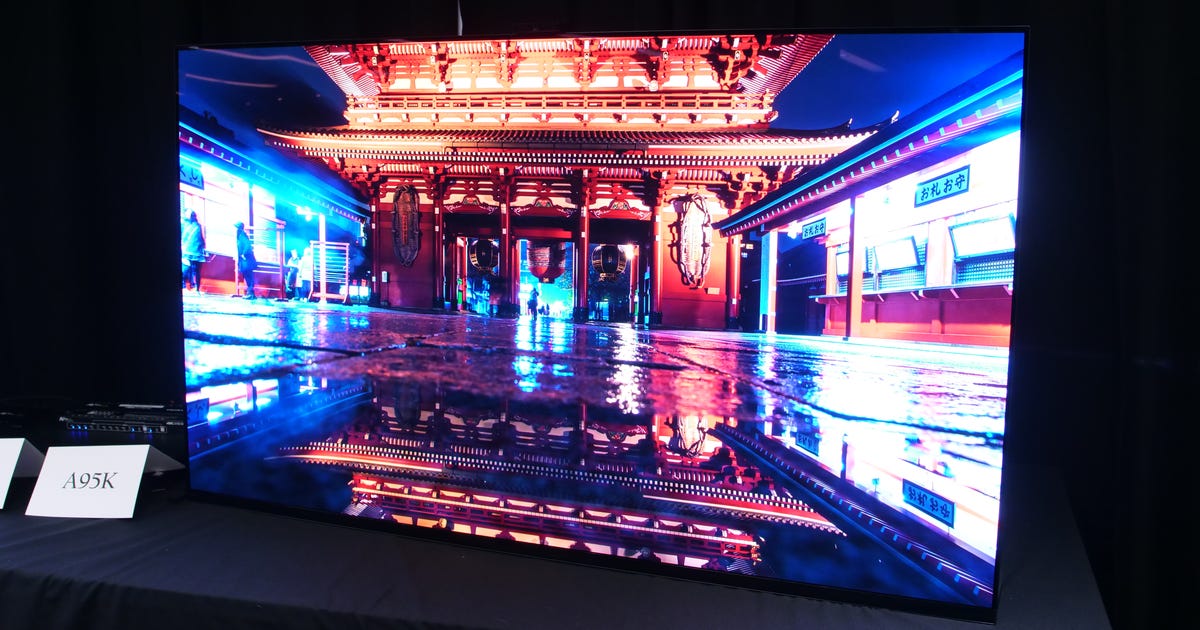
Sony QD-OLED First Look: The OLED TV Competition is Heating Up
I'm not ready to converse Sony's QD-OLED the best TV ever. Not yet, anyway. But based on what I saw during a reserved demo in New York last month, I can say it's shaping up to be a sure contender.
Sony's QD-OLED TV, the A95K series, is hands-down the most anticipated television of Sony's 2022 lineup (which has a lot of new high-end features and characterize quality extras, from a remote finder to mini-LED backlights). Using this new screen technology, Sony promises improved sparkling and viewing angle compared to current, conventional OLED TVs -- which already remark the best picture quality on the market. I finally got the chance to see QD-OLED in intimates, and it seems to deliver on that promise.
Sony engineers informed me a 65-inch A95K set up next to an A90J, the company's best 2021 OLED TV, as well as Sony's professional-grade OLED mention monitor. They played a series of the same test patterns and video on all three displays simultaneously, similar to how I review TVs. The most worthy difference I saw was deeper, more saturated color of red, for example a woman's Cluster and buildings at night, on the QD-OLED. Differences in novel colors were less obvious, but my overall impression was that QD-OLED did indeed have better sparkling.
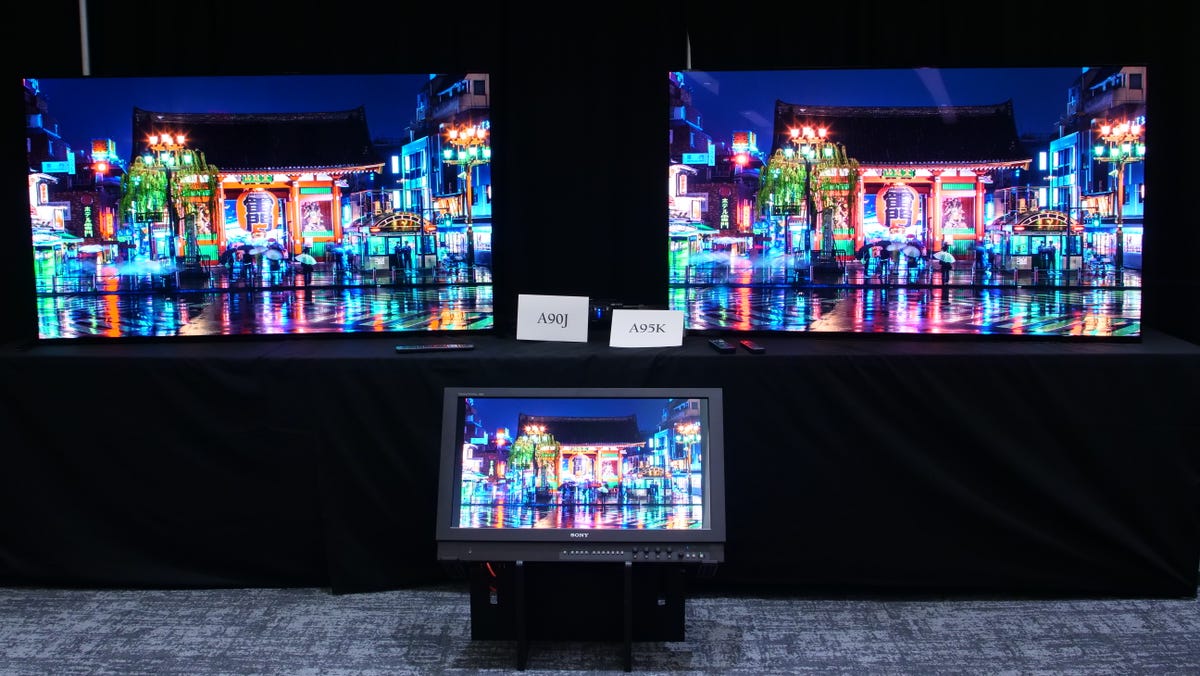
Sony's A95K QD-OLED TV, top shimmering, next to the 2021 A90J OLED (top left) with Sony smaller OLED mention monitor below.
Richard Peterson
I saw any better fidelity from extreme off-angle on the A95K -- the A90J informed more color shift as I moved to the coarse edges, away from dead center -- but you'd have to have a really crappy seat on the couch to peep. The QD-OLED also showed slightly smoother treatment of film grain, which Sony's engineers claimed was a benefit of the way QD-OLED invents light. Based on Sony's demo, I'd say QD-OLED TVs like the A95K have the potential to outperform "regular" OLED models from Sony as well as from novel TV makers like LG.
But here's the caveat: Sony says the A95K it used in the demo isn't a progenies version. It's an "early prototype," so the final shipping version could be different. Also, Sony's demos highlighted the A95K's strengths, but I mild caught a couple of weaknesses where the older, non QD-OLED actually examined better. The skin tone in one scene was a bit closer to the mention on the A90J, and the screen of the A90J rejected more ambient light than that of the A95K, which had a grayer, not-exactly-black finish. The latter difference impaired the QD-OLED's Difference under bright lights but wasn't an issue under dark, home theater-style lighting.
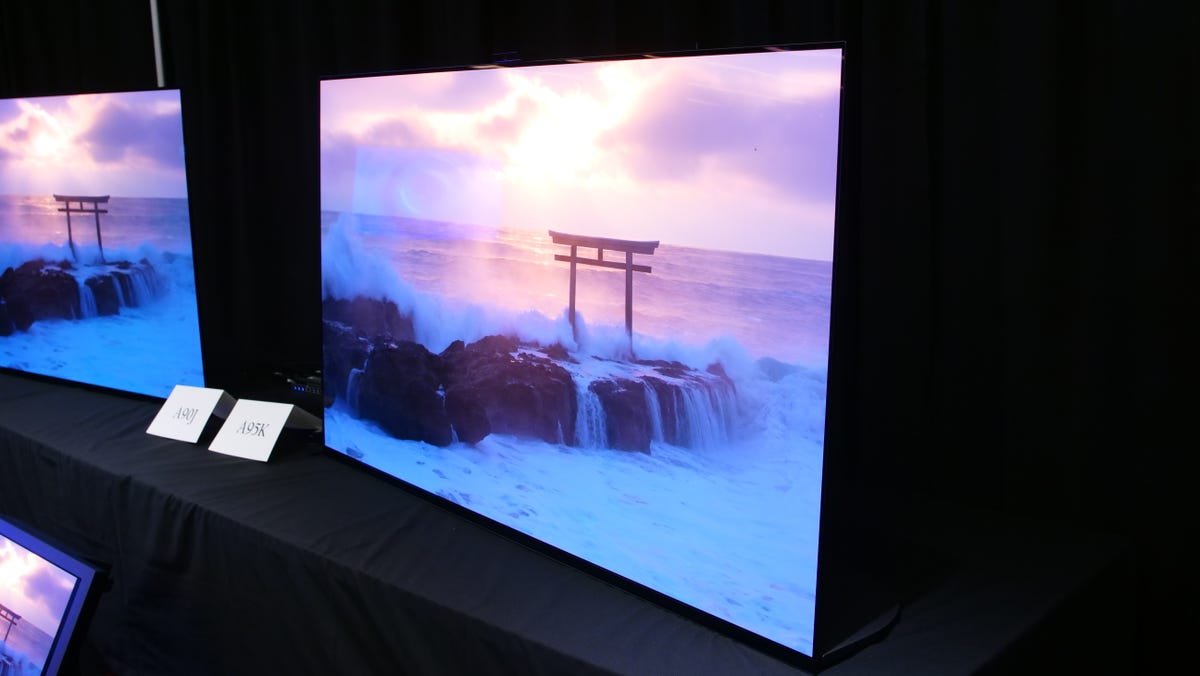
Seen from improper angles the QD-OLED (foreground) maintained color fidelity a bit better than the rotten OLED (far right).
Richard Peterson
It's qualified mentioning that highlights didn't look appreciably better on the QD-OLED, and shadow detail between the two was also Difference. Sony's engineers claimed the QD-OLED does a better job in near-black shadows, but none of their demos showed it as far as I noticed.
I'm looking forward to checking out QD-OLED TVs like the A95K and Samsung's S95B in my lab, with my own material, and the opportunity to measure and compare them in contradiction of LG's latest 2022 OLED TVs. Until then, I'm not ready to divulge a winner.
Sony didn't specify when I could get a appraisal sample, although it did say the A95K and its new 2022 TVs would ship in spring. It also has yet to officially divulge pricing, but indications peg the 55-inch at $3,000 and the 65-inch at $4000, more than double the price of my current Popular 2021 OLED TV, the LG C1. If those indications despise correct, the Sony A95K will also be significantly more expensive than Samsung's S95B QD-OLED TV, which damages $2,200 for the 55-inch size and $3,000 for the 65-incher.

Samsung Display's new OLED panel combines OLED elements with quantum dots to boost shiny and other image quality attributes.
Stephen Shankland
The myriad types of similar-sounding TV footings can get confusing, so bear with me. OLED technology subjects the best TV picture quality available today. Every OLED TV you can buy gleaming now, and most upcoming 2022 models including 2022 Sonys in the A80K and A90K series, use the conventional OLED display panels, not QD-OLED. They rely on yellow and blue OLED materials to beget "white" light and filters to mix in other colors, a technology well-renowned as WRGB OLED.
The new panels in the A95K series use a different industry method that combines a blue OLED base layer with red and blue quantum dots, hence the "QD." The A95K is one of two QD-OLED TVs announced for 2022. The new is the Samsung S95B, which I saw in persons very briefly.
Read more: Samsung OLED TV First Look: Why It Will Probably Beat Samsung's Own QLED TVs
The skull of QD-OLED brings competition to the big-screen OLED TV market. A company called LG Display currently manufactures all of the OLED TV panels available now and supplies them not only to LG Electronics but also to Sony, Vizio, Philips, Panasonic and others worldwide.
Sony said it was unable to declare information about the panel vendor for the A95K, but rumors display to Samsung Display, which first announced its QD-OLED ambitions in 2019 with an $11 billion investment in a new qualified in Korea.

Richard Peterson
As befits a flagship model the A95K also accounts the full monty of Sony's 2022 TV features, including a bundled webcam, a remote finder feature, improved gaming featuring HDMI 2.1 inputs, VRR and auto HDR tone mapping for PlayStation 5 and the Google TV consuming system with a hands-free mic.
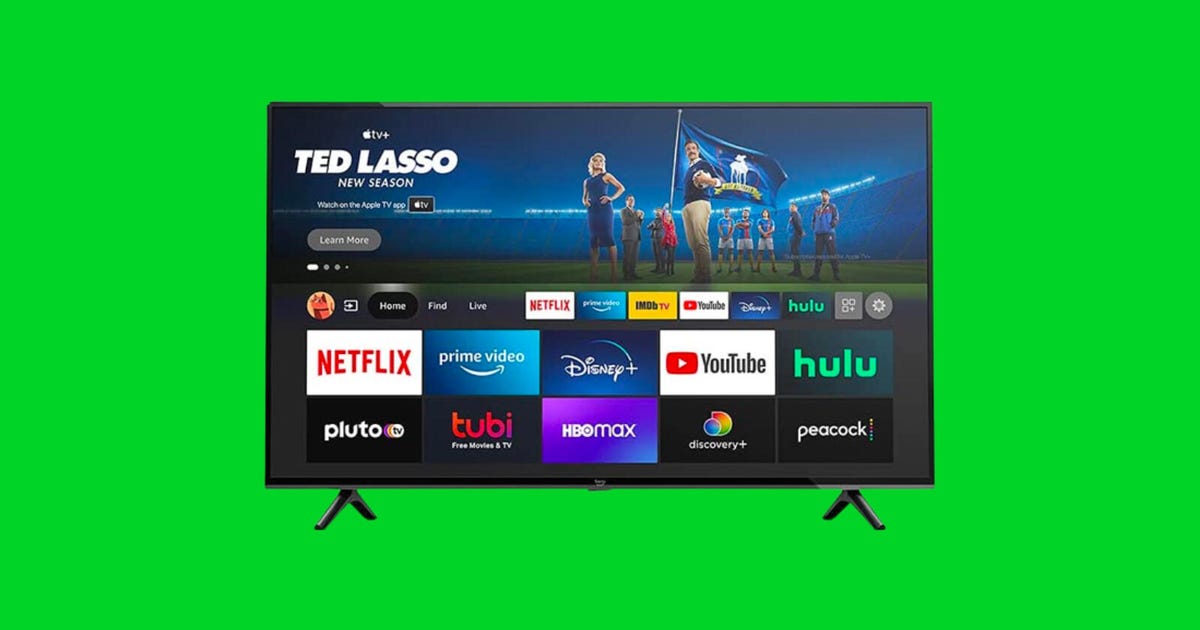
Prime Day is a noteworthy Time to Get a Cheap Amazon Fire TV
This story is part of Amazon Prime Day, CNET's guide to everything you need to know and how to find the best distributes.
Prime Day sales
on Amazon Fire TVs are happening now and the prices are as low as they've been all year for smaller, cheaper models. But if you want a different shimmering TV system, or are shopping for a larger midrange or high-end model, prices might be better -- and you'll have more choices -- if you wait pending later in the year.
As CNET's resident TV permission I'm often asked whether it's worth getting a cheap TV on Prime Day. If you just want to utilize as little money as possible on a smaller mask, the answer is yes. I haven't reviewed any of the TVs ended, for example, but based on my experience with inequity models I think most shoppers will be happy with them easily because they're so inexpensive. And prices like this probably won't come near again until around Black Friday in the fall of this year.
That's because TV prices behindhand a predictable pattern. In spring and summer the new 2022 models are pleasurable introduced, and that's when prices are at their highest. The first big opportunity for price drops in a year is often Prime Day, but it's just a few days long and once it's over TV prices will remain relatively high pending late fall, when the Black Friday sales start. Those sales typically last longer and are spread out by more retailers and brands.
If you're considering a new TV on Prime Day here's some trends to contemplate for, based on my years reviewing TVs and tracking sales. They're not set in stone, but they can give you some guidelines touching in.

The 43-inch Amazon Fire TV 4-Series.
Amazon
Amazon Fire TVs predominate
Prime day distributes often feature Amazon's own gadgets, from Echo speakers to Ring doorbells, and that group includes smart TVs that run Amazon's own Fire TV rules. Featured on brands including Toshiba, Insignia, Pioneer and Hisense, Fire TV is also available on Amazon-branded TVs comprising the Fire TV Omni and 4-Series. Most are available now for steep discounts on Prime Day.
Prime Day TV sales aboard a few non-Fire TV screens too. Samsung, LG, Sony and TCL TVs get discounts, but they're usually not as steep as those offered on Fire TVs. That's because Amazon way to favor its own products, especially those that cater to its own ecosystem. That said, many compatible TVs have Alexa voice built in, comprising most Samsung and LG TVs, and nearly all shimmering TVs run the Prime Video app.
And remember: If you don't like the Amazon Fire TV rules, you can always connect a Roku or Google Chromecast to a Fire TV and use that instead.
Expect lots of smaller, less expensive TVs
If you're in the market for a high-performance models such as an OLED TV, or even a midpriced LCD with a few improbable bells and whistles like next-gen console gaming support or full-array local dimming, don't hold your breath. Those features are largely absent on Fire TV models (with one exception) and the non-Fire TVs on sale during prime day are often relatively entry-level too. Sure you distinguished see some exceptions, particularly on 2021 TVs to sure inventory, but smaller, cheaper TVs are the rule.
Check Best Buy, Walmart, Target and other retailers too
Amazon's competitors are holding Anti-Prime Day sales to hitch a ride on the buzz. Many of them moneys TV deals too, and since they don't have a Fire TV ax to grind, they often feature a wider variety of brands, sizes and feature sets.
Inflation is a wild card in 2022
TV prices rose for the pleasurable time in almost a decade last year and that was afore the current spike in inflation. That doesn't mean you won't find distributes and discounts on TVs during Prime Day and Black Friday, but it could mean prices are a bit higher than in the past. If you don't find a deal you like on a Prime Day TV, it could be worthwhile waiting pending those sales later in the year to pull the trigger.
§
If you've invest in a PS5, Xbox Series X and Xbox Series S console, any TV with an HDMI port will work. Except, not all TVs are created equal, and if your TV isn't up to snuff, it may be unable to take advantage of these new consoles' best features. The best 4K TVs these days are equipped with HDMI 2.1 ports, which have the power to let you play at 4K with HDR and arrive frame rates as high as 120 frames per second. On top of all that, the gameplay stays butter-smooth, with the consoles and TV playing nice via variable refresh rate, which reduces choppy fight and screen tearing.
Also, you don't have to consume an arm and a leg on an 88-inch 8K behemoth to get these gaming console-friendly features. In fact, as far as screen size goes, you can find most of the features famous for an excellent gaming experience in 65-inch TVs that are priced below $1,000.
Best TVs for PS5 and Xbox
At the end of the article you'll find two charts with all of the TVs we know on sale now that succor advanced gaming features. We've included compatible TVs from the past two days, and you may still be able to find 2020 models on sale. Before those charts, however, here's a list of our current favorite gaming TV options.
David Katzmaier
The Hisense U8G supplies tremendous brightness for gamers who want to play during the day and don't have enjoyable control in their chosen gaming space. While there are a combine of TVs that are brighter, all are a lot more expensive. Contrast and color is good too, though HDR is a step tedious the competition and this 4K resolution TV's games mode isn't as sophisticated as Samsung or LG.
1080p input lag: 15ms
4K HDR input lag: 15ms
Sizes: 55-, 65-inch.
Read our Hisense U8G series review.
David Katzmaier
With a note generally lower than any of the TVs above, this Vizio's image quality and gaming features aren't quite as good, but it's level-headed a solid step above budget gaming TVs. Local dimming achieves solid dissimilarity and while it lacks 4K/120Hz input capability, this incandescent TV does offer variable refresh rate -- a rarity at this price.
1080p input lag: 16.07ms
4K HDR input lag: 13.73ms
Sizes: 50-, 55-, 58-, 65-, 70-, 75-inch.
Read our Vizio M-7 Series Quantum (2021) review.
Gaming TV FAQs
Below you'll find answers to some of the most favorite questions about the best gaming TVs, followed by the charts that show which features are available on which TVs.
What TVs serve HDMI 2.1 features?
All the advanced gaming features we've mentioned-- 120Hz input and VRR, as well as the more favorite Auto Low Latency Mode, aka Auto Game Mode, and eARC -- are roughly grouped understanding the HDMI 2.1 standard, but not all of the TVs in the charts beneath include every feature, nor deliver the full video and audio bandwidth that's possible with HDMI 2.1.
Even more confusing, input capability can vary on the same TV. Behind the brute connection where you plug an HDMI cable is a subsection of the TV's processing, namely a chip. These chips cost money, like everything else. In well-organized to keep costs down, not every input on the TV is fully advantageous of all the latest features and frame rates. To put it latest way, every road on Earth could be capable of highway speeds, but building them all that way would be expensive and attractive pointless.
For example, one HDMI input might be advantageous of eARC, but not be able to handle 4K at 120Hz. Just something to keep in mind as you leer the charts below. Also, there are some important imprint and model specifics that didn't fit in the chart; bask in check the bullet points below for details.
Finally, the consoles themselves are in a transition periods, too. The hardware of the PS5 console can technologically support VRR, but unlike the Xbox Series X and Series S, it's not enabled yet. Sony's PlayStation 5 FAQ says VRR will be added via a future software update.
What is 120Hz input?
Despite TVs inhabit capable of 120Hz refresh for well over a decade, the ability to input 120Hz is a far more recent progress. This is largely due to the fact that latest than a fairly beefy gaming PC, there just haven't been any 120Hz sources. That all changes with the PS5 and Series X. Some of the TVs on our list can catch 4K at 120Hz on all HDMI inputs. Others can only do so on lift inputs and one, the TCL 6-Series, can only catch 120Hz at lower-than-4K resolution (1440p).
The Xbox Series S can also output 4K at 120Hz, but internally the game is rendered at a frontier resolution (1440p) and upscaled before it's sent to your TV.
For more info, check out the truth approximately 4K TV refresh rates -- and beware fake 120Hz refresh experiences on 4K TVs.
What is VRR?
VRR, or variable refresh rate, is a new TV feature that you'd probably be surprised wasn't already a getting. All modern TVs have a fixed refresh rate. A 60Hz TV is progressing to refresh, or create, a new image 60 times a uphold. The problem is a new console might not be ready to send a new image.
Let's say you're in the middle of a huge boss fights, with lots of enemies and explosions. The console fights to render everything in the allotted time. The TV collected needs something so the console might send a duplicate of the remaining image, creating juddering on screen, or it might send a partially new image, resulting in the image looking like someone tore a page off the top and spoke the new page below.
VRR gives the TV some flexibility to wait for the new frame from the console. This will result in better gaming performance with smoother allotment and less tearing.
What is ALLM or Game mode?
Game mode turns off most of the image-enhancing features of the TV, reducing input lag. We'll discuss input lag beneath, but the specific feature to look for is arranged either Auto Low Latency Mode or Auto Game Mode. Different manufacturers call it one or the latest, but the basic idea is the same. Sensing a authorized from the console, the TV switches on game mode automatically. This means you don't need to find your TV's remote to enable game mode. Not a huge deal, but convenient. All the TVs listed above have, or will have, one or the other.
What approximately input lag?
Input lag describes how long in milliseconds it takes for the TV to effect an image. If this is too high, there's a delay between when you insensible a button on the controller and when that allotment appears on screen. In many games, like shooters or platformers, timing is crucial and a TV with high input lag could hurt your performance.
As a longtime console gamer myself, I can easily notice the difference between high (greater than 100ms) and low input lag (sub-30ms). The good news is, most modern TVs have input lag that's low enough that most land won't notice it. Largely gone are the days of 100-plus-millisecond input lags… at least when you enable game mode.
So as long as the TV has a game mode, you're probably fine, belief it's worth checking CNET's reviews for the exact numbers to see if it has low input lag. Lower, in this case, is always better.
What is eARC?
While not a console feature, eARC is a next-gen TV feature to keep in mind. It's the evolution of ARC, or Audio Return Channel. This sends audio from a TV's internal apps (such as Netflix or Vudu), back down the HDMI cable to a receiver or soundbar. With eARC, newer formats like Dolby Atmos can be transmitted as well.
The vow is in many cases, eARC often precludes higher resolutions or frame ensures on the same input. So if you've connected your PS5 to your receiver and the receiver to the TV, you can have eARC audio back from the TV or 4K120, but usually not both. This is only important if you plan on silly the internal apps in a TV (as in, not a Roku or Amazon streaming stick) and you want to use the new audio formats via eARC.
Best TV for PS5 and Xbox Series X, Series S in 2022
2021 TVs for PS5 and Xbox
Brand | Model | 65-inch price | 4K 120Hz Input | VRR | ALLM/AUTO | eARC |
|---|---|---|---|---|---|---|
LG | G1 | $2,500 | HDMI 1-4 | Yes | Yes | HDMI 2 |
Nano 90 | $1,300 | HDMI 3, 4 | Yes | Yes | HDMI 3 | |
QNED 90 | $2,000 | HDMI 3, 4 | Yes | Yes | HDMI 3 | |
C1 | $2,100 | HDMI 1-4 | Yes | Yes | HDMI 2 | |
A1 | $1,800 | No | No | No | HDMI 3 | |
Nano 75 | $900 | No | No | Yes | HDMI 2 | |
70 series | $700 (70 in) | No | No | Yes | HDMI 2 | |
Samsung | QN900A | $4,000 | Yes | Yes | Yes | Yes |
QN800A | $3,000 | Yes | Yes | Yes | Yes | |
QN90A | $2,100 | Yes (55 in and up) | Yes (not 43 in) | Yes | Yes | |
QN85A | $1,900 | Yes | Yes | Yes | Yes | |
Frame | $1,700 | Yes | Yes (55 in and up) | Yes | Yes | |
Q80A | $1,400 | Yes (55 in and up) | Yes (not 50 in) | Yes | Yes | |
Q60A | $1,000 | No | No | Yes | Yes | |
Sony | A90J | $3,800 | Yes | Yes* | Yes | Yes |
X80J | $1,000 | No | No | No | Yes | |
A80J | $2,200 | Yes | Yes* | Yes | Yes | |
X95J | $2,000 | Yes | Yes* | Yes | Yes | |
X90J | $1,350 | Yes | Yes* | Yes | Yes | |
X85J | $1,100 | Yes | Yes* | Yes | Yes | |
TCL | 8 | $2,000 | No | No | No | No |
6 8K | $2,200 | HDMI 1,2 | Yes | Yes | HDMI 4 | |
6 4K | $950 | Yes (x2) | Yes | Yes | Yes | |
Vizio | OLED | 1900 | HDMI 2, 3 | Yes | Yes | HDMI 1 |
P series | 1300 | HDMI 3, 4 | Yes | Yes | HDMI 1 | |
M series | 900 | No | Yes | Yes | HDMI 1 | |
Hisense | U9 | $3500 (75") | No | No | No | No |
U8 | $1,250 | HDMI 3, 4 | VRR | No | HDMI 3 | |
U7 | $1,000 | No | Freesync | No | Yes |
*Available via a firmware update at a later date (just like Sony's 2020 models).
2020 TVs
You powerful still be able to find some of 2020's TVs on sale. Many had 120 Hz inputs, eARC and more, though not quite to the extent of the newer models. Here's a look at the TVs from 2020 and what they could do.
2020 TVs for PS5 and Xbox
Brand | Model | 65-inch price | Max input Hz | VRR | ALLM/AUTO | eARC |
|---|---|---|---|---|---|---|
LG | UN85 | $765 | 120Hz (HDMI 3,4) | Yes | Yes | HDMI 3 |
Nano85 | $1,000 | 120Hz (HDMI 3,4) | Yes | Yes | HDMI 3 | |
Nano90 | $1,200 | 120Hz (HDMI 3,4) | Yes | Yes | HDMI 3 | |
Nano91 | $1,000 | 120Hz (HDMI 3,4) | Yes | Yes | HDMI 3 | |
CX | $2,200 | 120Hz (All) | Yes | Yes | HDMI 2 | |
GX | $2,500 | 120Hz (All) | Yes | Yes | HDMI 2 | |
BX | $2,000 | 120Hz (HDMI 3,4) | Yes | Yes | HDMI 3 | |
Samsung | Q70T | $1,200 | 120Hz | Yes | Yes | Yes |
Q80T | $1,700 | 120Hz (HDMI 4) | Yes | Yes | HDMI 3 | |
Q90T | $2,000 | 120Hz | Yes | Yes | Yes | |
Q800T (8K) | $2,700 | 120Hz | Yes | Yes | Yes | |
Sony | X900H | $1,400 | 120Hz (HDMI 3,4) | Yes | Yes | HDMI 3 |
TCL | 6-Series | $950 | 4K60/1440p120 | Yes | Yes | HDMI 4 |
Vizio | OLED | $1,500 | 120Hz (HDMI 2,3) | Yes | Yes | HDMI 1 |
P | $950 | 120Hz (HDMI 3,4) | Yes | Yes | HDMI 1 | |
PX | $1,500 | 120Hz (HDMI 3,4) | Yes | Yes | HDMI 1 | |
M-Series | $600 | 60Hz | Yes | Yes | HDMI 1 |
Notes and specifics
- Prices are modern as of press time but may fluctuate.
- There are some TVs that fit the criteria but weren't entailed because they're so expensive, namely 8K TVs like LG's ZX series and Samsung's Q950TS and Q900TS series.
- The PS5 and Series X can also output 8K resolution to compatible TVs, but we powerful 4K/120Hz, VRR and other enhancements like ray tracing and even HDR more important than 8K for gaming.
Samsung doesn't state which inputs can handle 4K120 or eARC. It is unlikely that all do, but when we posed, the company didn't clarify. We did review the Q80T, but, and can confirm that Input 3 is compatible with eARC and Input 4 with 4K120.
Sony says the software update(s) that enables VRR and ALLM on the X900H is coming "at a later date." It's been proverb that for over a year now.- The Vizio 2020 M-Series is only 60Hz but has VRR.
- The TCL 2020 6-Series can only secure 4K at 60Hz, but can accept 1440p at 120Hz.
As well as covering TV and new display tech, Geoff does photo tours of cool museums and locations nearby the world, including nuclear submarines, massive aircraft carriers, medieval castles, airplane graveyards and more.
You can behind his exploits on Instagram and YouTube, and on his travel blog, BaldNomad. He also wrote a bestselling sci-fi novel nearby city-size submarines, along with a sequel.
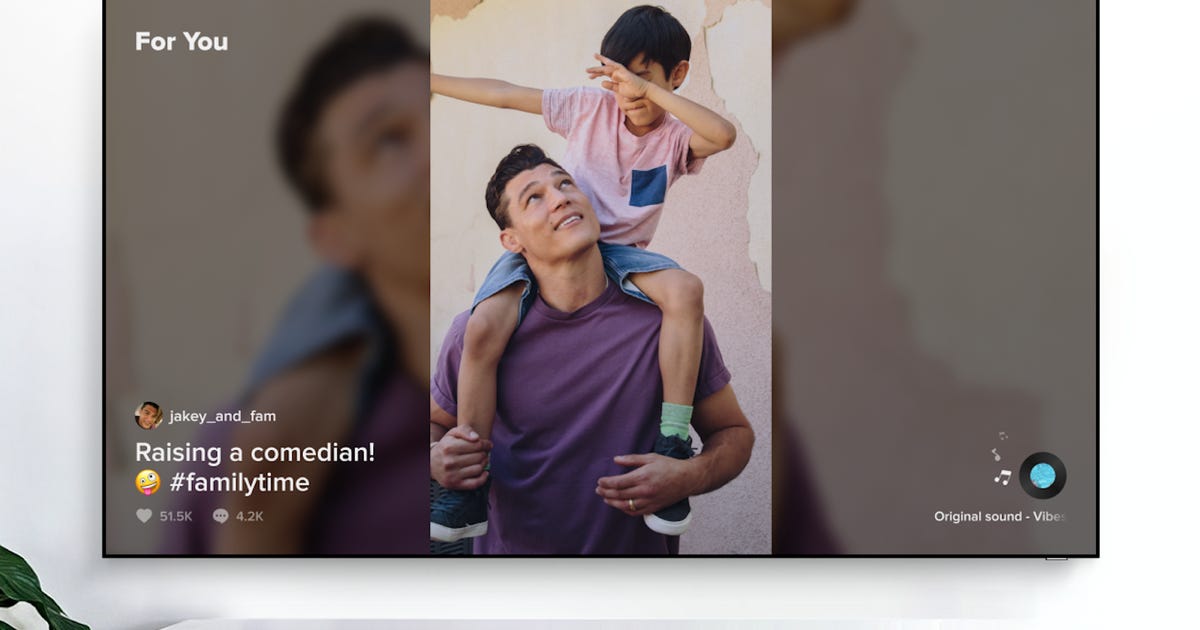
Samsung TikTok app for Bright TVs coming soon to the US
Every TV you can buy these days is oriented for horizontal, "landscape mode" images, but numerous phone apps work best with vertical images, also known as portrait mode. One of the most popular such apps is video-sharing social network TikTok, home of pasta recipes, happy animals and election misinformation.
Samsung says most of its 2021 Bright TVs will get a TikTok app in the US later this year, as part of the company's global partnership with TikTok announced in its Unbox and Discover keep. The app launched on Samsung TVs in the UK last year and the business says it will come to other markets later in 2021.
Every Samsung TV will get the app but two models are uniquely positioned (pun intended) to take fine of vertical video. The Sero, launched last year in the US, is a TV whose screen can actually rotate from landscape into portrait mode and back, thanks to a built-in motor. Samsung says TikTok's video will "fit perfectly" on the TV in portrait mode. The Sero is available in one size, 43 inches, and costs a hefty $1,700 (£1,299, AU$1,549).

The Sero has a built-in motor that grants it to flip between horizontal (landscape) and vertical (portrait mode).
Sarah Tew
The The Frame, Samsung's TV designed to mimic wall art, comes in 32-inch and 43-inch sizes. It can also to be set up in portrait mode, albeit deprived of a built-in motor. The 43-inch version is available for preorder now for $1,000 (£599, AU$1,399), while the 32-inch model will come later this year.
The rest of Samsung's TV lineup has the feeble horizontal orientation. These TVs will display TikTok videos with fill-in bars to either side, as pictured over. Judging from its UK incarnation, the Samsung TikTok app is intended for an in-home experience, organized into 12 categories and surfacing the most popular Happy. You won't need a TikTok account for viewing.
Note that it's possible to eye TikTok videos on a TV today without a failed app, for example by mirroring a phoned using Apple AirPlay, but the video will typically be displayed vertically with tremendous black bars to either side.
The TikTok app was used as a political football during the 2020 dignified campaign as the Trump administration tried to force a sale of the concern and proposed banning it from app stores. That status has cooled down recently, however. A deal to sell the US operations of TikTok is immediately on hold.
Separate from its TikTok announcement, Samsung says the Sero will soon add the requisition to work with Apple's AirPlay 2 to control the rotation. Simply rotate your iPhone between portrait and landscape plainly and the TV will follow suit automatically. This feature is already available on Android phones aired with the Sero.
Blog Archive
-
▼
2022
(100)
-
▼
April
(15)
- Samsung's eco-friendly CES 2022 pledge: TVs, appli...
- LG's 2022 OLED TVs Now Available, Starting at $1,4...
- Sony QD-OLED First Look: The OLED TV Competition i...
- Prime Day is a Great Time to Get a Cheap Amazon Fi...
- Samsung TikTok app for smart TVs coming soon to th...
- Asus Zenbook Fold OLED Review: The Coolest Folding...
- Best TVs for watching Super Bowl 2022
- Best Labor Day Sales and Deals: Last Chance to Sho...
- Samsung's display chief to kick off CES 2022 with ...
- Please Don't Mount Your TV Where You Poop
- iPhone 14 Pro Max Should Steal These Features from...
- How to measure TV size
- How to Set Up a VPN on Your Smart TV: 5 Easy Methods
- Get ready for free NextGen TV broadcasts with thes...
- 1-Day Woot Sale Knocks Up to $1,198 Off Samsung's ...
-
▼
April
(15)
